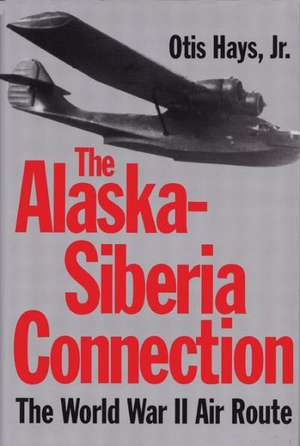The Alaskan-Siberia Connection: The World War II Air Route: Texas A & M University Military History (Hardcover), cartea 0048
Autor Otis Haysen Limba Engleză Hardback – 30 iun 1996
American Lend-Lease generosity helped to join Russia and America in a wartime alliance against Germany. However, Russia, suspicious of American sincerity, delayed the establishment of an Alaska-Siberia delivery route (known throughout the war as ALSIB) to the German war front. Instead, other routes via the North Atlantic and the Persian Gulf were employed for the delivery of urgently needed aircraft in 1941-42.
Eventually, recognizing that an ALSIB route would allow the delivery of American-made aircraft in days, not weeks or months the Russians agreed to the ALSIB route in late 1942.
The ALSIB route became the fastest and most productive means of moving combat aircraft to the Russian-German front. Additionally, although it was primitive and dangerous, it established a direct and time-saving artery between Moscow and Washington, and it was heavily used by diplomats, politicians, and countless military officials, both Soviet and American.
Declassified official U.S. military records and selected Russian sources, as well as reminiscences from former American liaison officers who were stationed at ALSIB posts in Alaska between 1943 and 1945, serve as the basis for this intriguing story.
Otis Hays's "The Alaska-Siberia Connection: The World War II Air Route, " presents the untold story of how the Soviets and Americans worked together to deliver fighting aircraft where they could be used effectively, shared always dangerous and sometimes deadly subarctic flying hazards, surmounted most of the language and cultural barriers they faced, and staunchly refused to allow mutual mistrust to overcome their efforts.
Preț: 316.71 lei
Nou
Puncte Express: 475
Preț estimativ în valută:
60.61€ • 62.62$ • 50.42£
60.61€ • 62.62$ • 50.42£
Carte indisponibilă temporar
Doresc să fiu notificat când acest titlu va fi disponibil:
Se trimite...
Preluare comenzi: 021 569.72.76
Specificații
ISBN-13: 9780890967119
ISBN-10: 0890967113
Pagini: 200
Dimensiuni: 162 x 235 x 20 mm
Greutate: 0.52 kg
Ediția:New.
Editura: Texas A&M University Press
Seriile Texas A & M University Military History S., Texas A & M University Military History (Hardcover)
ISBN-10: 0890967113
Pagini: 200
Dimensiuni: 162 x 235 x 20 mm
Greutate: 0.52 kg
Ediția:New.
Editura: Texas A&M University Press
Seriile Texas A & M University Military History S., Texas A & M University Military History (Hardcover)
Notă biografică
Otis Hays, Jr., is the author of "Home from Siberia: ""The"" Secret Odysseys of Interned American Airmen in World War II, " also published by Texas A&M University Press. He served as a senior member of the Alaska Defense Command's military intelligence staff and was the responsible staff supervisor of the command's foreign liaison operation in 1943-44. He lives near Pierce City, Missouri.
Textul de pe ultima copertă
American Lend-Lease generosity helped to join Russia and America in a wartime alliance against Germany. However, Russia, suspicious of American sincerity, delayed the establishment of an Alaska-Siberia delivery route (known throughout the war as ALSIB) to the German war front. Instead, other routes via the North Atlantic and the Persian Gulf were employed for the delivery of urgently needed aircraft in 1941-42. Eventually, recognizing that an ALSIB route would allow the delivery of American-made aircraft in days, not weeks or months, the Russians agreed to the ALSIB route in late 1942. The ALSIB route became the fastest and most productive means of moving combat aircraft to the Russian-German front. Additionally, although it was primitive and dangerous, it established a direct and time-saving artery between Moscow and Washington, and it was heavily used by diplomats, politicians, and countless military officials, both Soviet and American. Declassified official U.S. military records and selected Russian sources, as well as reminiscences from former American liaison officers who were stationed at ALSIB posts in Alaska between 1943 and 1945, serve as the basis for this intriguing story.














